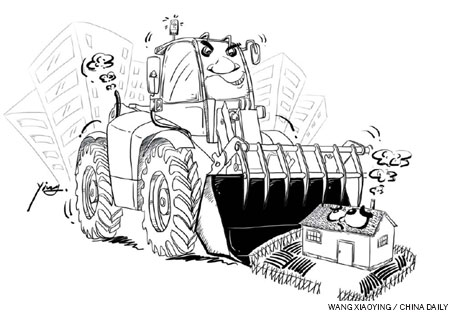Opinion
Rural income and the future
By Michele Geraci (China Daily)
Updated: 2011-05-27 11:24
 |
Large Medium Small |

One of the hottest topics in China today is food prices, especially prices of agricultural products and how to increase farmers' income. The government's monetary policies are well suited to curb rising vegetable and fruit prices, though natural calamities and external shocks sometimes reduce agricultural yields, which in turn increase prices. But fortunately their effects are short-lived and prices fall after a couple of months.
The problem of how to increase farmers' income is somewhat more complex and its solution not so easy.
At the risk of over-simplification, it appears that the solution to the current problem is urbanization, that is, encouraging farmers and, more generally, rural residents to move to cities where they can get jobs, save as much as possible and remit a large portion of their income to their families in rural areas.
| ||||
But if we look at how rural households' income has evolved over time, the picture that emerges is less rosy. National Bureau of Statistics figures show that rural net income from household operations (including all rural activities like farming, animal husbandry, fishery and forestry) has grown by an average of only 7-8 percent a year over the last 10 years, well below nominal GDP growth.
The figures indicate that, although economic conditions have improved in real terms (rural CPI being only about 3 percent a year on average), rural residents have not benefited proportionately from the overall wealth created within the country. This situation is, however, mitigated by the larger increase in income derived from non-rural activities, such as wages and salaries, so that total income of rural residents has grown by about 10 percent a year. In simple terms, farmers take up employment elsewhere to boost their income.
One of the causes of this phenomenon is, once again, urbanization: Encouraging farmers to move to cities does greatly help them increase their income, but it also squeezes out those who are left behind.
Urbanization increases real estate prices and rents for retailers, who are forced to increase their sale prices. None of the increases is passed on to the producers, though. Urbanization expands the areas of cities. As a result, land that was once verdant becomes home to skyscrapers, increasing the distance between producers and consumers and raising transport costs - none of which benefits the producers.
Even the current policy of maintaining 1.8 billion mu, or 120 million hectares, of arable land is not stopping the transformation of rural land at the edges of cities into concrete jungles, which is achieved through the so-called land-swap system.
Land swap is the process by which a city government first demolishes low-rise rural houses far from the city hub and then moves residents into newly built high-rises, thus increasing the occupancy per/unit of surface. By doing so, it effectively increases the area of arable land within its jurisdiction, which creates a sort of "credit" - or excess land, if you wish. This "credit" can then be used to turn "rice fields" in the immediate vicinity of the city into land for urban development. This way, the overall arable land area remains unchanged, but the city manages to push the countryside further away.
We said at the beginning that the winners are people who leave rural land and move to cities. But there is a final twist: Urbanization, which depletes the countryside of people, should eventually help increase the average income of those who remain in the fields (same land but fewer people working on it) and at some time an equilibrium point should be reached that would make agricultural activities relatively acceptable, provided mechanization and increase in the average size of farms are achieved.
At this point, rural residents who have been the main drivers of such urbanization now sit on the other side of the value chain. They are consumers of agricultural products and end up paying the - now higher - price for the products that were cheaper when they were producing them.
Of course, any potential second thoughts of returning to the - by-then profitable - land and abandoning the city as their home would be impossible to realize, because by then they would have acquired urban resident status and given up their rural hukou (household registration) and the land that came with it.
Side effects of urbanization are tricky to predict and in this area, China is the first country to implement a program on such a massive scale. This time, there is not much relevant experience that can be learnt from other countries. China will have to continue to rely on its so-far extremely successful philosophy of trial and error, that is , "mo zhe shi tou guo he", or "crossing the river by feeling the stones". Let us hope the stones are there, somewhere under the water.
The author is head of China Program at the Global Policy Institute of London Metropolitan University and senior research fellow at Zhejiang University.
| 分享按钮 |



